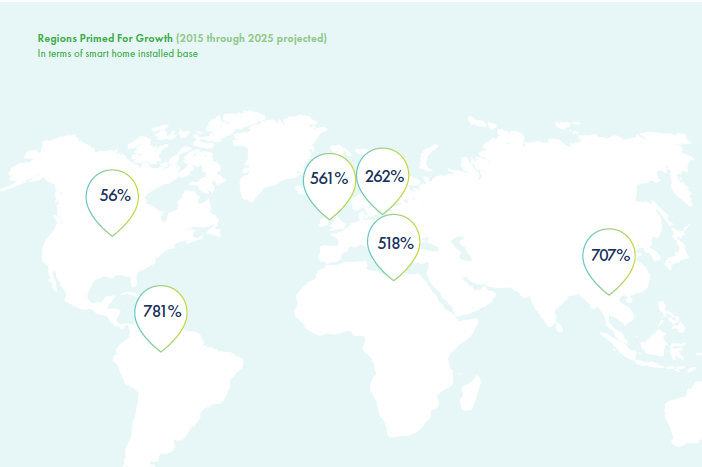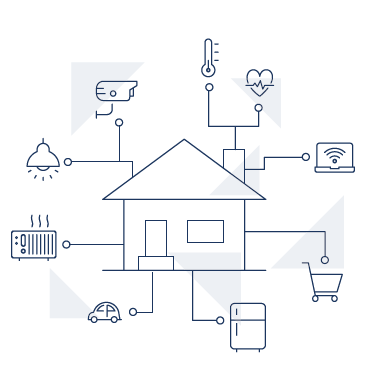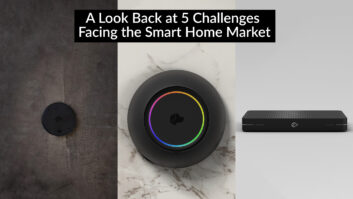A lot has happened since January 1, 2020, and the smart home industry has not been immune to these changes. The Covid-19 pandemic has had, and will continue to have, a major influence on the smart home industry as now, more than ever, consumers are spending more time at home and looking to new projects that can bring added convenience during these challenging times. The additional time being spent at home has consumers eager to invest time, effort, and money into home renovations and upgrades — and all of us in the smart home industry are in a unique position to sell and install the technology.
Despite the opportunities for growth, there have also been numerous challenges — supply chain interruptions and retail closures, manufacturing impact, and social distancing requirements restricting physical installs have all caused a hiccup in smart home’s rapid growth. Insight from a recent ABI Research study found that smart home revenues will reach $85B in 2020, just a 4 percent increase over 2019.
Although 2020 has brought unforeseen challenges, there are still opportunities for growth and places for everyone in the industry — manufacturers, integrators, developers, retailers, and others — to contribute to building a better smart home experience for consumers and end-users. Staying abreast of industry trends has never been more important, as the smart home industry continues to pivot and shift post-Covid.
In our recently released Z-Wave State of the Ecosystem 2020 report, we examine smart home and connected technology — from both within and outside of the home — and explore the smart home landscape as it exists today, current and future trends, data compiled, and new opportunities with an emphasis on the role Z-Wave technology plays in the advancement of the industry.
Let’s look at three major takeaways from the report.
Related: Z-Wave Alliance Releases 2020 State of the Ecosystem Report
The Need to Shift
In a post-pandemic world, the smart home value proposition will need to shift
Although we began work and data collection for the report pre-Covid at the beginning of the year, we recognized the significance of the pandemic and the ways in which it would impact the smart home market, along with the very way we live our lives.
We asked experts on their thoughts for how the smart home industry would need to pivot post-pandemic. Ideas included a rise in demand for smart entertainment devices, as well as a need for stronger network capabilities, with more people spending time at home streaming entertainment content, working, and learning, and a renewed focus on using smart home technology to keep people connected, both inside the home and at a distance.
“In a post-pandemic world, I think the smart home’s greatest opportunity will be facilitating connections between people,” said Stacey Higginbotham of Stacey on IoT. “Instead of simply focusing on aging-in-place (for example), we should look for technology that helps people feel connected to their loved ones both inside the home and at a distance.”

The Z-Wave smart home categories and regions primed for growth support larger market demands
The Z-Wave product categories most primed for growth (according to ABI Research) through 2025 are all-in-one devices, or smart devices with hubs built in, i.e., a smart security system or display that also functions as a gateway, smart doorbells, and water sensors. This data supports the larger trend we’re seeing across the entire industry of security still being a leading category and opportunity for consumer entry into the smart home, but it also opens the door for new categories to experience growth. One reason for the predicted growth of smart water sensors may stem from new incentives to install the devices for premium or other discounts from home insurance carriers.
While smart home has seen consistent, year-on-year growth in North America, it is in international markets that we expect to see some of the strongest opportunities for growth. The same data from ABI Research found that the regions most primed for growth through 2025 were in Latin America and the EMEA regions. In Europe, strong economic growth, increased investment and interest in solutions like smart lighting and water from public utilities, and rapid urbanization are all contributing factors to industry growth.
And in Latin America, reasons behind growth include increased investment from highly-populated countries like Mexico and Brazil in IoT and smart cities initiatives and policies, as well as projected economic growth.
Also by Mitchell Klein: Connecting the Smart Home

Interoperability, ease-of-use and setup, security, and new technology like AI will be critical to the continued success of the smart home — especially post-Covid.
In our report, we surveyed industry experts and media (including Residential Systems editor, Tony Savona) across a wide range of verticals to get their take on the future of smart home — what they see as challenges, opportunities, and trends to come through 2020 and beyond.
The majority of those quoted seemed to agree on what the industry needs to prioritize to ensure continued growth; device and network interoperability remains a critical point, as many consumers cite continued frustration with device incompatibility, which can lead to high return rates and disinterest. It can also contribute to device ease-of-use and setup — another common concern amongst consumers.
The professional install community can leverage these concerns as an opportunity to show the value of professional vs. DIY smart home. “It is all about interoperability,” said Tony Savona in the report when asked about the greatest opportunities facing the smart home market in 2020 and beyond. “Getting everything in the house to talk to one another through one control system is key to greater acceptance and users moving to the next level.”
Network and device security remain other important opportunities for manufacturers and developers to improve, and new technology, such as AI and contextual awareness, or the opportunity for technology to learn and execute on routines or room occupancy, are also cited as important considerations for smart home growth.
Read more insight and industry takeaways in our full report, available for free download at https://z-wavealliance.org/z-wave-state-of-the-ecosystem-report.
Mitchell Klein is executive director for the Z-Wave Alliance.







